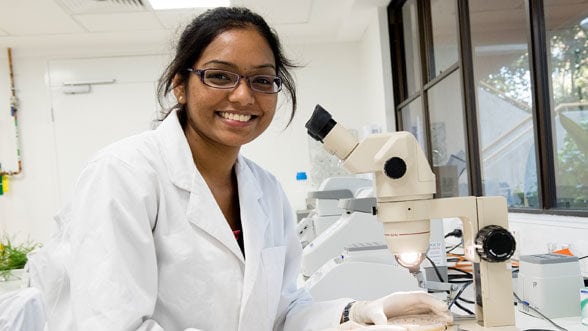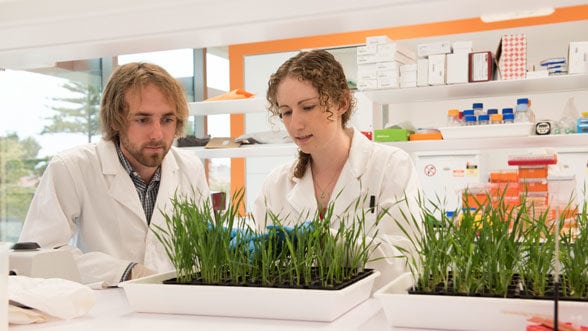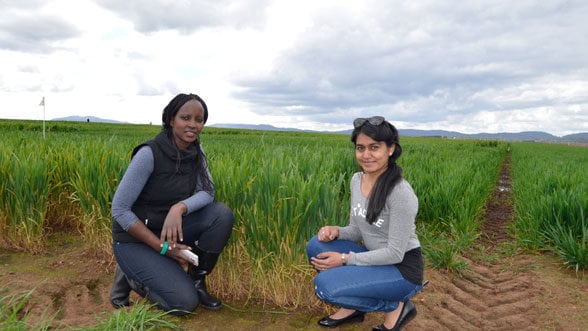Honours Projects
Chemistry
See the full list of Chemistry honours projects available
Food and Agriculture
CCDM
CCDM offers a wide range of Honours Projects and our available ones are listed below. If you would like more information on the projects or the application process, please contact CCDM@curtin.edu.au, clearly stating the name of the project and the nature of your query.
Sclerotinia in lupin
Project outline: Lupin is an important legume and break crop in the northern agricultural region of the WA grainbelt. However, it is susceptible to sclerotinia in wetter years, along with canola which is widely grown in the region. This project will be looking at variation between current varieties and advanced breeding lines, and differences in isolates of sclerotinia and their aggressiveness of infection. The project involves mainly glasshouse studies with some work in the lab culturing isolates. It may also involve some field work scoring breeding trials (linked to CCDM research and in collaboration with Australian Grains Technologies)
Exploring the toxic secretions of the barley Net Blotch fungi.
Stipend amount – available on enquiry
Project outline: Pathogens secrete several molecules into their environment, some of which are toxic to the host. Using analytical techniques such as chromatography you will explore the “secretome” of different Net Blotch isolates to correlate these toxins with barley susceptibility.
Carpogenic germination temperature triggers in sclerotia – what is the upper limit?
Stipend amount – available on enquiry
Project outline: The production of apothecia (small mushroom-like structures) from sclerotes in the soil, that release spores are the primary reproductory method of Sclerotinia in the field. Recent research has shown that maximum germination occurs at alternating diurnal temperatures of 20/15°C, but that no germination occurs at 30/15°C. What is the upper limit beyond which germination does not occur between these two temperatures.
Functional studies of host-selective toxins in P. nodorum
Project outline: A set of toxin candidates were identified using GWAS panel of 154 P. nodorum isolates. The objective of the project is to characterise the predicted effectors by cloning them into a protein expression vector and generating gene deletion mutants. Effector activities and effector impact on pathogenicity will be assessed using various genetics and biochemical techniques.
Characterisation of the infection of Brassica napus by Sclerotinia sclerotiorum using light and confocal microscopy
Project outline: S. sclerotiorum is the causal agent of sclerotinia stem rot in canola (B. napus). Under normal circumstances, S. sclerotiorum produces ascospores that infect B. napus plants via fallen petals lodged in leaf axils. Using the petals as an initial substrate for germination, the fungus grows through the stem and can lead to major yield loss by causing plant lodging. In other species, such as Helianthus annuus (sunflower), S. sclerotiorum infects predominantly through the roots. It is not known whether and how this occurs in B. napus. This project would involve histopathological characterisation of leaf, stem and root infection with S. sclerotiorum mycelium. The student would conduct infection assays with resistant and susceptible B. napus lines to generate samples for staining and detailed microscopic analyses. To aid confocal microscopy experiments, we have generated a green fluorescent protein expressing S. sclerotiorum mutant strain.
Characterisation of candidate genes for the Sclerotinia sclerotiorum UV-mutant with reduced pathogenicity on canola
Project outline: S. sclerotiorum is the causal agent of sclerotinia stem rot in canola (Brassica napus). In the CCDM we have generated sequencing data for a S. sclerotiorum UV-mutant obtained from US collaborators, which has reduced pathogenicity on canola and other broad-leafed host crops. The student would align the sequencing data to the reference genome for sclerotinia and identify the mutations in genes that lead to a non-functional gene. The student would then use a targeted gene knock-out transformation system established in the CCDM lab to independently knockout the identified genes to determine which gene-knockout gives rise to the reduced pathogenicity phenotype.
Are there fitness costs in pathogens developing fungicide resistance with target site mutation and copy number variation in the gene encoding target fungicide protein?
Project outline: The types and mechanisms of fungicide resistance may be many and varied, but two of these include a mutation leading to modification of fungicide target site (e.g., a single amino acid substitution) and copy number variation in a gene encoding a fungicide’s target protein. Such cases were recently identified in Pyrenophora teres f. teres, Ptt (the causal agent of net form of net blotch in barley) by our team. Existence of copy number variations in different isolates of a pathogen can be expected to affect some aspect of the life history trait and/or fitness of the respective isolates. In this project, the potential candidate, will explore pathogen fitness in isolates of Ptt that carry target site mutation, or mutation plus varying number of gene copies, along with wild type isolates.
Population genetics of the current Australian P. nodorum collection
Project outline: Septoria nodorum blotch (SNB) is a complex disease of wheat caused by a fungal pathogen known as Parastagonospora nodorum. The ability of the pathogen to adapt and successfully infect a wide range of wheat lines in many parts of the world lies in its evolutionary potential. A set of P. nodorum isolates will be isolated from newly obtained SNB disease samples. Thirty SSR (Simple Sequence Repeats) markers which were developed to represent the whole genome of the pathogen will be used for population structure analysis. Implications of the results will be used to design wheat breeding strategies for more sustainable SNB resistance and more generally for pathogens with NEs.
Understanding different pathogenicity profiles of core Australian P. nodorum isolates on wheat using GWAS
Project outline: A panel of 220 wheat lines which are insensitive to all three known effectors of P. nodorum pathogen (ToxA, Tox1 and Tox3) will be used to assess pathogenicity profiles of core Australian P. nodorum isolates which are representative of a collection of Australian P. nodorum population using Genome Wide Association Study (GWAS) analysis.
This study is to:
- assess pathogenicity potentials of the isolates,
- identify novel effectors produced by the pathogen and receptor from the host in Australian context; and
- develop KASP markers for identified genomics regions which are highly associated with the disease incidence in the host.
The markers will be validated for their potential use in MAS (Marker Assisted Selection) wheat breeding programs for better septoria nodorum blotch disease resistance.
Tools and techniques to measure changes in the rate of photosynthesis in diseased crop plants
Project outline: Photosynthesis is an important determinant of crop productivity and its impairment could result in devastating yield losses. Pathogenic fungi use various chemical and physical signals to interfere and reduce the rate of photosynthesis in host plants. In the case of a necrotrophic fungal pathogen, the rate of photosynthesis is not only drastically reduced in the necrotic lesion but also in tissues directly adjacent to it. The aim of this project is to establish novel techniques and tools to determine the gradual change in the rate of photosynthesis in wheat plants showing symptoms of yellow spot. Furthermore, the rate of photosynthesis will be assessed in infected plants pre- and post-fungicide treatment.
Modelling the yield penalty of canola infected by sclerotinia
Project outline: Canola is an adaptable plant and typically grows to fill the space available even when establishment is poor. Therefore how much infection is required within a plant and within a crop to lead to yield loss across the paddock.
Modelling the risk of sclerotinia infections using APSIM
Project outline: APSIM is a researcher modelling tool that is used to model plant development and subsequent yield in relation to a range of agronomic, soil and climatic factors, allowing predictions under various scenarios such as reduced rainfall into the future. However it currently does not include options for disease within the crop.
Temperatures required to initiate the germination of sclerotia of sclerotinia
Project outline: Published research is predominantly from northern hemisphere temperate environments where the crop is sown in spring into increasing temperatures. In Australia, canola is sown in autumn into decreasing temperatures. What influence does this have on sclerotia germination?
Genome evolution and adaptation mechanisms of fungal pathogens
Project outline: Comparing hundreds of genomes from public databases or sequenced in-house, you will predict genes responsible for causing crop disease, identify regions of pathogen genomes that are ‘adaptation hotspots’, and predict horizontally-transferred genes common to distantly related pathogen species.
Is disorder is the key to success? (for fungal pathogens)
Project outline: Many proteins have conserved 3D structures that correspond to their functions and are required for their molecular interactions, but some require ‘intrinsic disorder’ (instability) instead. You will predict disordered proteins and investigate relationships with virulence in known pathogenicity proteins.
Mining for mycoviruses in fungal genomes
Project outline: Viruses of fungi (mycoviruses) are capable of altering the virulence of fungal plant pathogens. Using cutting-edge sequence similarity search algorithms, you will search across multiple genomes and transcriptomes to discover novel mycoviruses.
Redefining pathogenicity effector families and their improving predictive power
Project outline: Build up a database of plant “cell-killing” protein toxins, then mine it to discover novel amino acid patterns common to proteins with pathogenicity functions. This resource will then be applied to predict new pathogenicity proteins across the fungal kingdom.
Comparative genomics of foliar fungal pathogens of narrow-leafed Lupin
Lupin is an emerging crop of significance in agriculture, livestock and human health, but its broader use is limited by fungal diseases. You will leverage existing genome sequence resources for 7 major lupin pathogen species, to perform bioinformatic comparisons and determine gene content specific to pathogenicity in lupin.
Grass: A secret host for wheat disease?
Stipend amount – up to $10,000 for one year
Project outline: Wheat disease is a constant problem and can impact across other crops and grass species. We want your help in investigating the reactions of host and non-host plants to fungal disease and toxins. This research will give you the chance to put a range of skills and scientific approaches to the test.
Pathogen gene discovery: Toxic or not?
Stipend amount – up to $10,000 for one year
Project outline: Looking for a project that combines bioinformatics and molecular biology? You could play an important part in identifying and testing potential new toxins of major crop pathogens as part of your Honours project. Gene expression during plant infection will be studied and proteins purified to determine crop toxicity.
Get smart with wheat breeding
Stipend amount – up to $10,000 for one year
Project outline: Want to play a role in crop improvement? This project could the one you are looking for. We are looking for someone to develop and test new genetic markers closely linked to genes for wheat disease resistance. Fluorescence-based PCR techniques will be used to screen markers on wheat varieties. Useful markers can then be passed to breeding companies for identifying disease resistance in commercial germplasm.
Up or down? Explore gene expression
Stipend amount – up to $10,000 for one year
Project outline: Many fungal genes play a role in crop disease, such as those encoding toxins or enzymes for degrading plant cells and overcoming plant defences. This project asks you to examine the expression levels of the pathogenicity genes of a major wheat fungal pathogen. You will be using a range of molecular biology techniques such as RNA isolation, cDNA synthesis and qPCR.
What’s in a number? Exploring fungal chromosomes
Stipend amount – up to $10,000 for one year
Project outline: Chromosome size and number variations have been reported for fungal species, and this variation is known to play an important role in the evolution of virulence. When you take on this project you will be investigating the genome structure of a major fungal wheat pathogen, as well as the chromosomal location of pathogenicity genes. Your molecular biology skills will be put to good use as you work to uncover insights into pathogen genome plasticity.
Barley net blotch epidemiology, population genetics and gene flow
Stipend amount – up to $10,000 for one year
Project Outline: This project aims to examine the relative diversity of Net blotch isolates in Western Australia and the genetic structure of populations and their origin. You will be doing this through population genetics and gene flow analyses.
Fluorescent labelling of Botrytis and histology of plant infection in pulses
Stipend amount – available on enquiry
Project outline: Botrytis cinerea and B. fabae infect faba beans and lentils to cause the major plant disease, Chocolate Spot and Botrytis Grey Mould, respectively. You will use existing protocols and develop new ones, for the production of transgenic fungal isolates that produce Green Fluorescent Protein (GFP). GFP-labelled fungi will then be used to observe patterns of plant colonisation by fungi during infection, using confocal microscopy.
Genetic mechanisms of resistance and virulence of Ascochyta blight in chickpea
Stipend amount – available on enquiry
Project outline: Ascochyta blight is a major plant disease of chickpea and we have identified several candidate virulence genes in the causal organism, Ascochyta rabiei. You will develop knockout fungal strains for three candidate effector genes and characterise the mutant strains using plant pathology assays, and light and confocal microscopy.
Secondary metabolite clusters of Botrytis and plant infection in pulses
Stipend amount – available on enquiry
Project outline: Botrytis cinerea and B. fabae infect faba beans and lentils to cause the major plant diseases and there are differences between pathogen species in the complement of secondary metabolites produced. You will use gene knockout methods to manipulate the production of specific secondary metabolite synthetic genes to determine their role in pathogenicity. Microscopy will also be used to observe differences in the mode of infection for Botrytis in which specific secondary metabolite genes have been disabled.
Fluorescent fungi to visualise the progression of the net blotch diseases of barley
Project outline: The devastating fungi causing net blotch of barley have two faces, the net type and the spot type. Using genetically engineered fluorescent fungi and confocal microscopy, in this project, you will investigate from a histological perspective how these two organisms infect the plant and how the plant may stop them.
Seed and spores: investigating fungal disease on wheat grain quality and seed-borne transmission.
Project outline: This project will assess the extent of yellow spot disease infection in wheat grain. The extent of seed discolouration, deformation and presence of phenolic compounds will be investigated. Infected seeds will be sown and the transmission of disease from grain to germinated seedlings will be assessed.
Keeping it green – investigating the physiological impact of disease in exotic wheat landraces.
Project outline: This project will analyse physiological traits in genetically diverse wheat against the damaging fungal disease yellow spot. Microscopy and chlorophyll fluorescence imaging will be used to measure disease impact on photosynthesis. This project will involve lab and glasshouse-based work.
Find out more
If you would like to know more or talk through ideas and options for CCDM project inquiries, please contact CCDM@curtin.edu.au.
To find out more about Chemistry, Ecology, and Agriculture and Food Science projects, please contact MLS-Admin@curtin.edu.au


